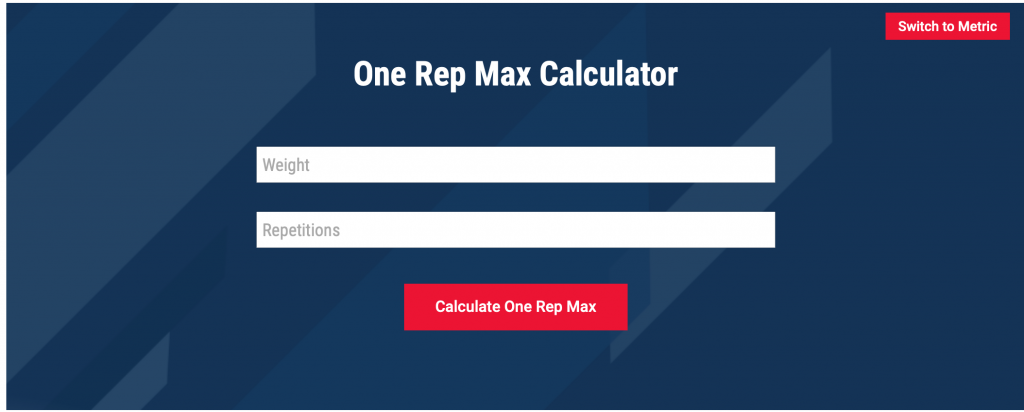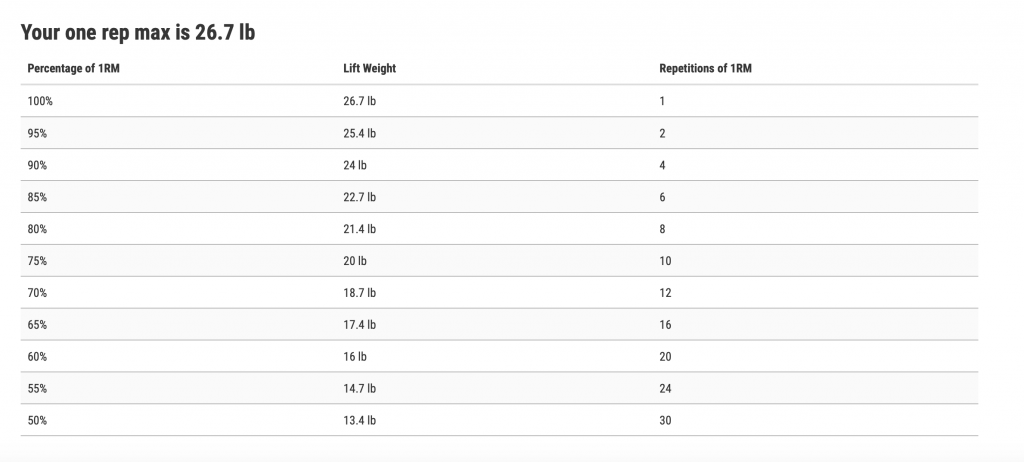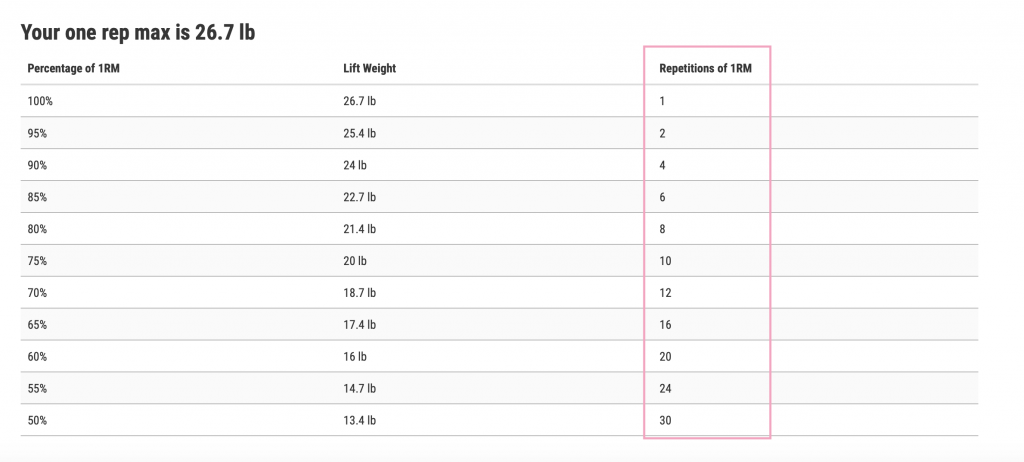Types of exercise
Recovery
Fitness myths
Evlo Programs
BODY COMPOSITION
All
Browse by category
Browse by category
Calculate the exact weight to lift for muscle growth
Payton Busker
10/28/2022
Written by

at home workout, dumbbells, fitness myths, fitness trends, lifting weights for women, resistance training, strength training, weight
Here at Evlo, we believe that strength training/lifting should be the cornerstone of your fitness routine. But there is a lot of conflicting “guidance” across the internet in regards to the best way to go about lifting. Some say you have to lift HEAVY, HEAVY. Some make arguments for low load, high repetition. Others use a combination. So what is the minimum amount of weight someone has to lift in order to see muscle growth (hypertrophy)? And how can you figure it out for yourself?
One Rep Max (1RM)
What is a one rep max (1RM)? It is the maximum amount of weight you can use for a single lift for 1 repetition. If you are able to get even two repetitions, that is not your true 1RM!
Knowing your 1RM for each lift that you perform is extremely beneficial!! Research shows that we need to lift at least 30% of our 1RMs for each lift in order to make hypertrophic changes to the muscles.
So should you go out and try to pick up the heaviest weight possible to find your 1 RM for each exercise? No! We have a better (and safer) idea for determining this value on your own.
How to calculate your 1RM for muscle growth
Determining your 1RM by trial and error with extremely heavy weights can be a dangerous task to perform on your own. Especially if you are not under the supervision of a healthcare or fitness professional!
Instead, we recommend that you “work backwards” to determine your 1RM value.
NASM developed a 1RM calculator to do just that! Here’s how it works.

Insert that weight that you used for the lift and the amount of reps it took you to get to failure. Getting to failure looks like not being able to complete another rep of whatever lift you’re performing.
The calculator will then give you the values from your 1 RM all the way down to 50% of this value.
To determine your 30% (remember this is the minimum you would need to lift in order to see muscle growth) you can simply multiply your given 1 RM value by 0.3.
Calculating 1RM for exercises that use external load (weight)
This calculation is pretty straight forward! Let’s use a biceps curl as an example.
Dumbbell weight: 20 lb
Repetitions to failure: 10 reps
1 RM generated value: 26.7 lbs
30% of 1 RM: 26.7 lbs X 0.3= 8.01 lbs
You can use this data to determine the minimum weight to lift for biceps muscle growth. Based on this calculation, you would need to use at least 8 lb dumbbells for your biceps curl to induce muscle hypertrophy.
Let’s look at one more. An Evlo staple for shoulders: Side lying shoulder abductions!
Dumbbell weight: 5 lb
Repetitions to failure: 15 reps
1 RM generated value: 7.5 lbs
30% of 1 RM: 7.5 lbs X 0.3= 2.25 lbs
You can use this data to determine the minimum weight to lift for deltoid muscle growth.So based on this calculation, you would need to use at least 2.25 lb dumbbells for your side lying abduction to induce muscle hypertrophy.

Calculating 1RM for for body weight exercises
Calculating 1RMs for body weight exercises might seem confusing at first, but can easily be estimated. Let’s take a look at some of our favorite body weight exercises!
Step ups (for glutes)
Here at Evlo, we typically perform step ups like this: First, you stand up all the way on a kitchen chair, bench, plyo box, etc. From there, you lower the none-working leg down and back towards the floor without letting it touch before standing back up again.
In order to determine the value to put in the “weight” section of the NASM calculator, simply subtract the estimated weight of the none-working leg from the rest of your body weight. Don’t worry about getting this estimation perfect!
Weight: 100 lb (approximate weight – weight of one leg)
Repetitions to failure: 15 reps
1 RM generated value: 150 lbs
30% of 1 RM: 150 X 0.3 = 45 lbs
Matrix move or sissy squats (for quads)
We love both matrix move and sissy squats for quad muscle hypertrophy. And both can be plugged into the 1 RM calculator using about ½ of your body weight! We use ½ of your body weight since we are primarily “lifting” your upper body in both moves.
Weight: 69 lbs (approximate upper body weight)
Repetitions to failure: 15 reps
1 RM generated value: 103.5 lbs
30% of 1 RM: 103.5 X 0.3 = 31.05 lbs
If you want to add a dumbbell to either of these exercises, simply add the dumbbell value to the weight used above! This would look like:
Weight: 89 lbs (approximate upper body weight + 20 lb dumbbell)
Repetitions to failure: 15 reps
1 RM generated value: 133.5 lbs
30% of 1 RM: X 0.3 = 40.05 lbs

What percentage of weight range should you aim for in your lifts?
Although 30% is the minimum amount of weight you should use, you might notice that this value seems fairly light when you do the calculations.
Using the NASM calculator, you can see that even down to 50% of your 1RM would require a lot of repetitions in order to get to muscle failure. That rep number would be even higher for your 30%! This would fall under the “low load, high repetition” category of weight training.

In our Build (lifting) classes, we keep the lifting intervals between 60-90 secs, cueing to get towards muscle failure within this time period. Taking your lifts towards failure within this time period is associated with recruitment of both type I and type II muscle fibers, contributing to muscle growth!
This would translate to more of a moderate repetition range. If you are only lifting 30% of your 1RM, you will most likely not reach failure within that 60-90 sec time period. Therefore, we would recommend aiming for at least 60% of your 1 RM per lift in each of our classes!
Play around with how these different weights feel! And don’t be afraid to include wrist weights to make incremental changes to the load. This can be a great way to exceed the minimum weight you need to lift in order to see muscle growth!
What about if you’re new to lifting weights all together?
If you’re new to lifting or to Evlo, give yourself time to get familiar with the lifts and movement patterns before trying to base your lifts off of your 1RM!
This will ensure that you are strengthening the motor patterns and neuromuscular connections prior to pushing towards muscle failure in your lifts. It’s also possible that body weight or fairly light weight will already be greater than your 30% value when you first start lifting!
Don’t rush the process. Save this blog post for when you’re ready to get more into the specifics of lifting and you feel really comfortable with the moves!

Evlo Member Experiment: How much weight should you lift in classes for muscle growth?
If you’ve been a member for a while, try this experiment during one week of classes!
- Count how many repetitions it takes to get towards failure for each lift we do in classes for the week
- Pause the video if you don’t get to get close to failure before we transition from the exercise and continue with the lift until you get there
- Write down the dumbbell value (if applicable) and reps
- After class, plug your values into the calculator and notice where your load falls on the percentage list!
From there, you can analyze!
- Are you lifting at least greater than 30% for all lifts?
- Are you getting to failure in 60-90 secs?
- Can you go up towards 60-75% in any of your lifts?
This way you can ensure that you are getting the most out of each and every class!